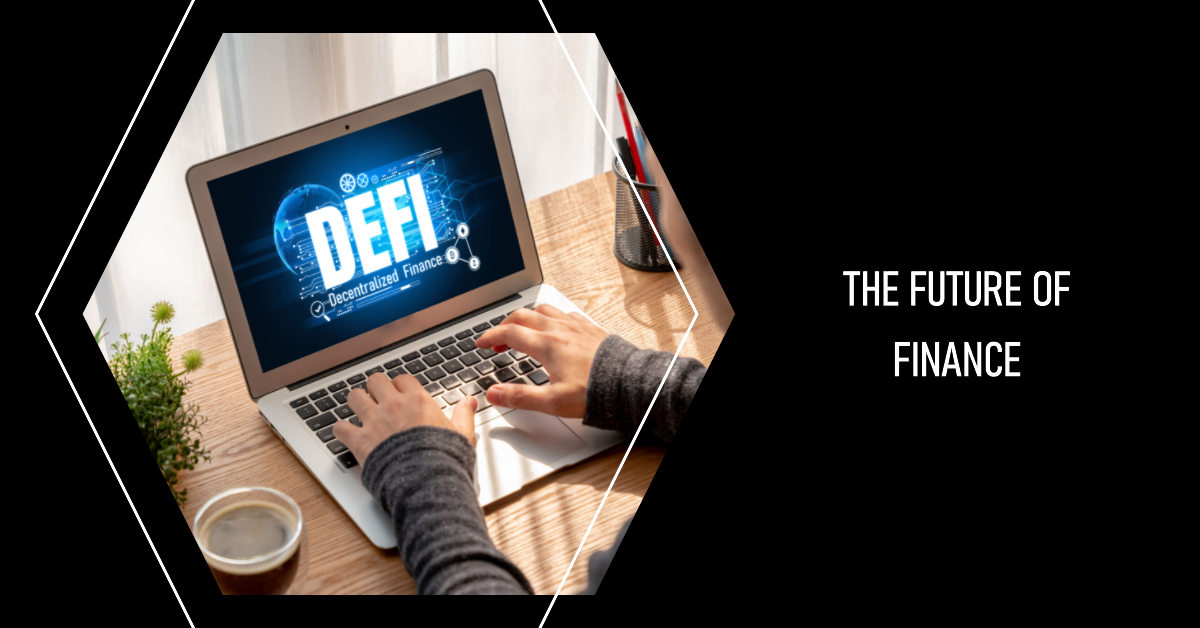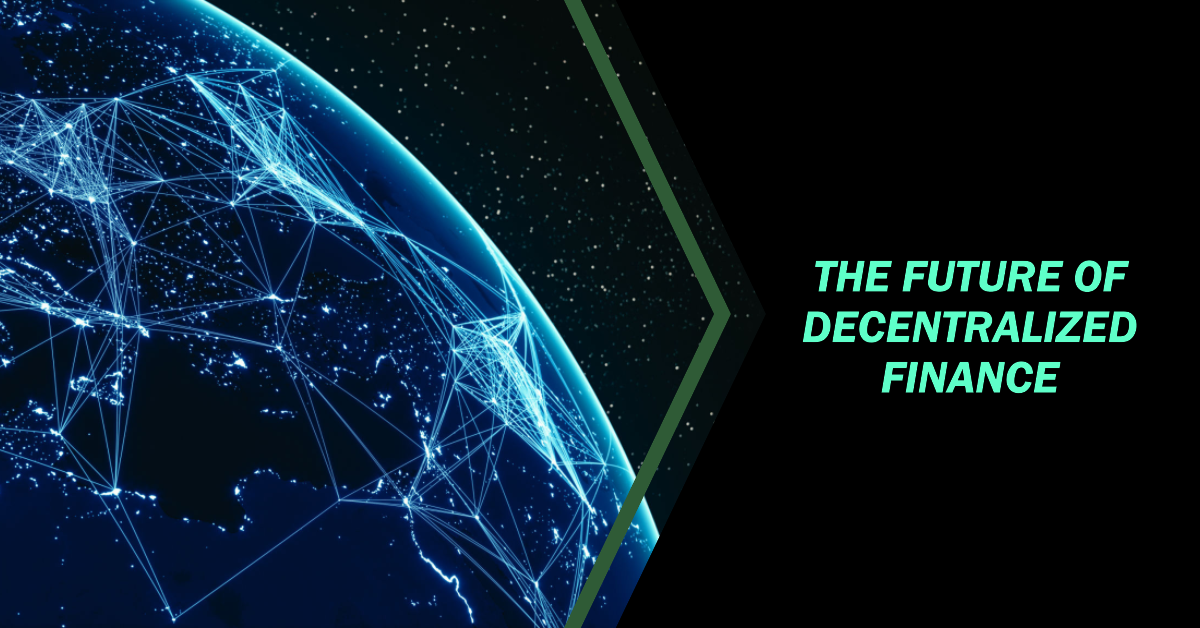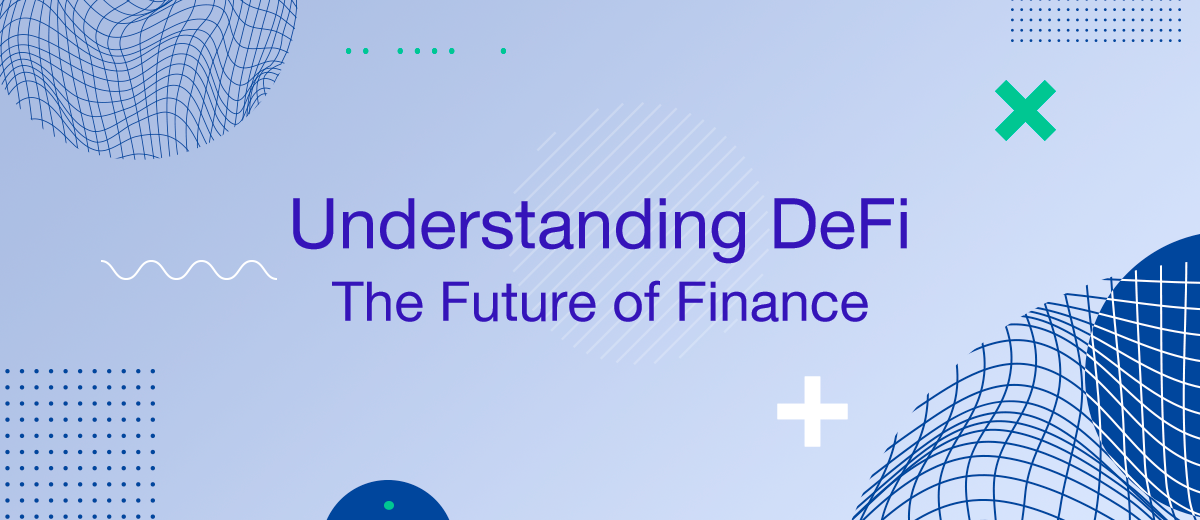Digitalization is a global, ubiquitous trend that has been radically changing and updating various areas of human activity for more than a year. Such innovations are especially active in the financial industry, from the already well-known cryptocurrencies to the latest technologies. One of the latest is decentralized finance (DeFi for short), which can completely replace the traditional financial system in the near future. In this article, we will tell you what is DeFi, how this technology appeared and developed, and what components it consists of. In addition, you will learn what the benefits, challenges, and risks of DeFi are, in which areas it is used, and its prospects for the future.
What is Decentralized Finance (DeFi)
Decentralized finance is a general term that refers to digital financial transactions on public blockchains (primarily Ethereum). They represent a new model for organizing financial services, transfers, and exchanges conducted in cryptocurrency. DeFi allows businesses and individuals to perform a range of transactions provided by traditional banks and financial institutions. For example, borrowing and lending; investing at interest; trading in securities; and selling and buying insurance. In DeFi, all these actions are faster and easier due to the lack of intermediaries, transparency, flexibility, and security of the technology.
Decentralized finance, created based on Ethereum, Bitcoin, and other popular cryptocurrencies, is an effective alternative to fiat (related to traditional money) financial markets and instruments. They significantly reduce the cost of their development and maintenance and also make them more open, free, and generally available.

The main feature of decentralized finance is the absence of a regulator that can issue or store assets, manage operations, and control users. Instead, such powers are distributed among all participants in the system in a decentralized way, using a peer-to-peer (P2P) method. Financial DeFi transactions between users are carried out through self-executing smart contracts based on Ethereum or other blockchains. They ensure the fairness and transparency of the transaction, protecting its participants from fraud or other risks.
Evolution of DeFi
Decentralized finance began to actively spread in 2017 after the emergence of smart contract technology on the Ethereum network. Over time, it became available for other blockchains as well. One of the first major DeFi projects is the MakerDAO landing platform, which released its own digital currency, the USD-pegged DAI stablecoin. It allowed users to issue and borrow loans in these "stable coins", regulating the process of loans and their payments using the same smart contracts.
In 2020, decentralized finance (DeFi) company Compound Finance began rewarding lenders and borrowers by rewarding them with their own digital token called COMP. Coins are the internal financial assets of this project. They can also be bought and sold on third-party cryptocurrency exchanges. Compound Finance has been followed by other DeFi platforms, giving the field yet another use. They became multi-level investments, known as liquidity mining or yield farming. Investors move their funds between pools on different crypto platforms, receiving interest from the deposit and additional rewards for this.


In the same year, Bloomberg reported that the DeFi industry had reached $9 billion in collateral and that the sector made up two-thirds of the cryptocurrency market. The sphere of decentralized finance attracted not only investors but also developers, who actively began to create DeFi projects based on Ethereum and other blockchains. At the same time, funding from venture investment funds appeared in the industry: Andreessen Horowitz, Michael Novogratz, and others. In 2022 and 2023, a tangible challenge for DeFi was pressure from the authorities of a number of countries (primarily the United States) to regulate this area.
Key Components of DeFi
Decentralized finance uses blockchains as infrastructure and cryptocurrencies as units of account. Major cryptocurrencies (such as Ethereum and Bitcoin) allow DeFi platforms to create their own token coins based on their blockchains. What is DeFi token? These assets are issued by various projects and represent both their internal means of payment and the object of trading on crypto exchanges. Since the bulk of DeFi projects operate in the Ethereum ecosystem, most DeFi tokens comply with the Ethereum ERC-20 token standard.
The main components of decentralized finance are:
- dApps (decentralized applications) and protocols. These elements of DeFi provide the necessary infrastructure to carry out a wide range of financial transactions. They support transactions in two key cryptocurrencies: Bitcoin (BTC) and Ethereum (ETH), as well as tokens created based on their blockchains. They are usually available as browser extensions or web applications.
- Landing platforms. They provide decentralized lending services, acting as intermediary guarantors between lenders and borrowers of cryptocurrencies. DeFi lending has a collateral principle: to receive a loan, the borrower needs to deposit a certain amount of collateral in cryptocurrency. This ensures the anonymity of transactions, unlike similar banking services.
- Stablecoins. The value of these cryptocurrencies is pegged to traditional fiat currencies. Most often, to the US dollar. This ensures the stability of their exchange rate and increases their popularity as a means of payment and storage of crypto assets. Stablecoins are the best solution for those who are not satisfied with the constant fluctuations in the rates of conventional cryptocurrencies and who are looking for a more predictable alternative on the crypto market.
Benefits of DeFi
DeFi has a wide range of benefits that significantly improve and streamline cryptocurrency transactions, making them more secure, accessible, and feature-rich. Among the advantages of this technology are the following:
- Decentralization. The absence of a single regulatory center favorably distinguishes such projects from centralized finance (CeFi). Decentralization is a powerful security factor. It minimizes the risk of data loss due to technical failure or platform hacking.
- Publicity. Transactions in decentralized finance do not require confirmation from the regulator or, in principle, any third-party permissions. All the possibilities and limitations of DeFi operations are fixed in advance in smart contracts.
- Transparency. The smart contract model makes the logic and conditions of transactions clear to all participants in the system. All data is recorded in the blockchain network without hidden code or other information with limited access.
- Anonymity. Despite the transparency of smart contracts, users of DeFI platforms themselves can remain completely anonymous. They do not need to go through the identity verification (KYC) procedure common among centralized and regulated systems.
- Autonomy. Decentralization assumes that users themselves control their financial assets and ensure their safety. Therefore, the private keys to their crypto wallets are not stored on any third-party resources. This makes it impossible to restore access to the wallet in the event of data loss.
- Versatility. dApps have a wide range of applications; they can be used not only for financial transactions but also in other popular areas, including social networks, gaming, and more.
- Low commissions. The absence of intermediary regulators makes transactions in decentralized systems more profitable for users; fees are lower here than in CeFi. This is one of the key advantages of DeFi vs traditional finance.
Challenges and Risks in DeFi
DeFi has not only advantages but also certain disadvantages and risks. We list the main ones:
- Complexity. The decentralized finance system can be quite complex for untrained people, especially for those who have no idea about cryptocurrencies and blockchain. This factor has slowed down the mass introduction and distribution of DeFi technologies so far, not allowing them to fully replace traditional financial models.
- Support. The absence of centralized regulators limits the ability to solve problems and advise users. Often, they have to search for the necessary information on their own or seek help from the project community.
- Volatility. High volatility in the price of tokens is another potential risk of DeFi projects, arising from a lack of control and regulation.
- Safety. Users of decentralized finance systems are solely responsible for protecting their digital assets and other personal data. As a rule, DeFi platforms do not offer additional security measures on their part. Most often, it is impossible to restore access to the wallet in the event of hacking or loss of access. There are also a number of scams that are common among DeFi projects.
DeFi Use Cases and Real-world Examples
Accessibility, versatility, ease of implementation, and other features of decentralized finance allow them to be used in many areas. Today, DeFi technologies are used in the following areas:
- Financial operations. Their infrastructure is optimally suited for organizing various financial instruments, from ordinary P2P payment and transfer services to lending, insurance, and other similar services.
- Stablecoins. This popular means of circulation and storage of crypto assets is one of the key areas of application for DeFi technologies.
- DEX (decentralized exchanges). The best DeFi platforms for trading are becoming more popular every year and are gradually replacing centralized crypto exchanges (CEX) from the market. With their help, users can buy and sell cryptocurrency to each other directly through P2P transactions without resorting to intermediaries.
- Electronic wallets (e-wallets). The technology allows you to create standalone cryptocurrency wallets that operate independently of CEX exchanges and other centralized systems. Thanks to DeFi wallets, users can store, send, and receive various digital assets, as well as enjoy other useful features, including access to blockchain games.
- Profitable farming (yield farming). This popular DeFi investment tool allows investors to “freeze” their cryptocurrencies on specialized platforms for a certain period of time and earn interest in return. In fact, profitable farming is a decentralized analog of bank deposits.
- Non-fungible tokens (NFTs). Developed based on DeFi, NFT technology allows you to turn literally any digital content into tokens, including images, audio, video, and other types of files. They can then be bought and sold, just like other cryptocurrencies. The advent of NFT launched a massive industry of digital art objects, which are now actively bought and sold at online and offline auctions for a lot of money. NFT marketplace development services can contribute to the expanding DeFi landscape by enabling the trade of unique digital assets in a decentralized manner.
- Instant loans (flash loans). This is another financial instrument based on DeFi technology. With its help, users can take out loans without collateral. The key feature of instant loans is that the loan and return of cryptocurrencies are carried out in the same block of transactions.
- Wrapped bitcoin (WBTC). This method allows you to send bitcoins to the Ethereum network using DeFi tools. With WBTC, users can earn income from their bitcoins by lending them through decentralized lending platforms.
Future of DeFi
Today, decentralized finance, along with the rest of the crypto industry, is actively improving, so many are interested in its prospects as an alternative financial system. The development of DeFi technologies every year opens up new, effective ways to use them. However, this area is facing some problems due to the lack of regulation, infrastructure failures, hacks, and various fraud schemes.

When studying the relationship between DeFi and the future of finance, it is worth noting the regulation factor. The global financial system has been designed to consider the laws of individual financial jurisdictions. Each of them has its own set of laws and regulations. In the case of DeFi, any legislative regulation will essentially be ineffective because this system is based on the principle of decentralization, which excludes the possibility of any external regulation. The unmanageability and autonomy of decentralized finance complicate the process of their acceptance as a full-fledged alternative to traditional ones.
Conclusion
Decentralized finance (DeFi) is a relatively new and very promising technology that has emerged based on cryptocurrencies and their blockchains. Comparing traditional finance vs DeFi, it is worth noting that the latter has a number of advantages. These include decentralization, openness, transparency, anonymity, autonomy, versatility, and low transaction fees. On the other hand, this system also has its drawbacks, including complexity for the mass user, limited support, high volatility, and some security issues. However, the development of DeFi allows for the creation of a whole range of effective financial and investment instruments based on it. Over time, they may replace the traditional services of banks and other organizations.
Personalized responses to new clients from Facebook/Instagram. Receiving data on new orders in real time. Prompt delivery of information to all employees who are involved in lead processing. All this can be done automatically. With the SaveMyLeads service, you will be able to easily create integrations for Facebook Lead Ads and implement automation. Set up the integration once and let it do the chores every day.
